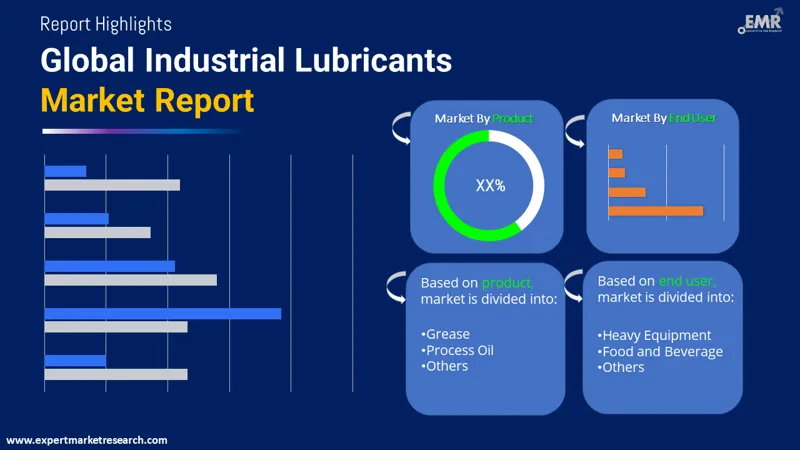
Consumer Insights
Uncover trends and behaviors shaping consumer choices today
Procurement Insights
Optimize your sourcing strategy with key market data
Industry Stats
Stay ahead with the latest trends and market analysis.
The global industrial lubricants market size reached a value of approximately USD 71.05 Billion in 2025. The market is expected to grow at a CAGR of 3.60% between 2026 and 2035, reaching a value of USD 101.20 Billion by 2035.
Base Year
Historical Period
Forecast Period
Compound Annual Growth Rate
3.6%
Value in USD Billion
2026-2035
*this image is indicative*
| Global Industrial Lubricants Market Report Summary | Description | Value |
| Base Year | USD Billion | 2025 |
| Historical Period | USD Billion | 2019-2025 |
| Forecast Period | USD Billion | 2026-2035 |
| Market Size 2025 | USD Billion | 71.05 |
| Market Size 2035 | USD Billion | 101.20 |
| CAGR 2019-2025 | Percentage | XX% |
| CAGR 2026-2035 | Percentage | 3.60% |
| CAGR 2026-2035 - Market by Region | Asia Pacific | 4.2% |
| CAGR 2026-2035 - Market by Country | India | 4.7% |
| CAGR 2026-2035 - Market by Country | China | 3.9% |
| CAGR 2026-2035 - Market by End User | Power Generation | 4.0% |
| CAGR 2026-2035 - Market by Product | Transmission and Hydraulic Fluid | 4.1% |
| Market Share by Country 2025 | Japan | 4.6% |
Industrial lubricants are substances that are applied to moving machine parts in order to reduce the wear and tear and friction between them. These lubricants are used for industrial applications as a boundary layer between two machine parts in order to allow smooth movement of a machine.

Read more about this report - REQUEST FREE SAMPLE COPY IN PDF
The EMR’s report titled “Industrial Lubricants Market Report and Forecast 2026-2035" offers a detailed analysis of the market based on the following segments:
Market Breakup by Product
Market Breakup by End User
Market Breakup by Region

Read more about this report - REQUEST FREE SAMPLE COPY IN PDF
By product, transmission and hydraulic fluid are anticipated to observe a rapid growth in the global industrial lubricants market owing to their comparatively lower cost and rising demand from the construction industry. Moreover, the non-compressibility, fire resistant property, durability, anti-wearability, and non-corrosive nature of transmission and hydraulic fluid are further increasing their demand globally, helping in the further growth of the market. The ability of these industrial lubricants to aid in moving heavy loads and providing greater force is also subjected to contribute to the growth of the overall market.
The Asia Pacific is expected to hold a sizable share of the market for industrial lubricants, supported by the widespread industrial development in the region and numerous manufacturing plants in countries like China. The increased spending by the government on the construction activities in countries such as China, Indonesia, and India are resulting in an increased demand for the industrial lubricants in the region. Meanwhile, North America is anticipated to observe a significant growth in the market during the forecast period owing to the increasing renovation activities and development of the commercial sector.
| CAGR 2026-2035 - Market by | Country |
| India | 4.7% |
| China | 3.9% |
| Mexico | 3.6% |
| USA | 3.4% |
| UK | 3.2% |
| Canada | XX% |
| Germany | XX% |
| Italy | XX% |
| Japan | 2.9% |
| Australia | XX% |
| Saudi Arabia | XX% |
| Brazil | XX% |
| France | 2.9% |
The comprehensive EMR report provides an in-depth assessment of the market based on the Porter’s five forces model along with giving a SWOT analysis. The report gives a detailed analysis of the following key players in the global industrial lubricants market, covering their competitive landscape and latest developments like mergers, acquisitions, investments and expansion plans.
Amsoil, Inc was founded in 1969 and is headquartered in Wisconsin, United States. It is a commercial company that primarily formulates synthetic lubricants, filters, and fuel additives for its customers.
BP p.l.c. is an oil industry company that was founded in 1909 and is based in London, United Kingdom. The company specialises in the supply chain of oil and natural gas, from exploration to marketing of energy products.
Carl Bechem GmbH was established in 1834 and has its headquarters located in North Rhine-Westphalia, Germany. This chemical manufacturing company produces high quality lubricants and metal working fluids for consumers globally.
*Please note that this is only a partial list; the complete list of key players is available in the full report. Additionally, the list of key players can be customized to better suit your needs.*
Other market players include Chevron Corporation, Repsol S.A., Eni S.p.A., Exxon Mobil Corporation, Fuchs Petrolub SE, Gulf Oil International Ltd, and Bharat Petroleum Corporation Limited, among others.




*While we strive to always give you current and accurate information, the numbers depicted on the website are indicative and may differ from the actual numbers in the main report. At Expert Market Research, we aim to bring you the latest insights and trends in the market. Using our analyses and forecasts, stakeholders can understand the market dynamics, navigate challenges, and capitalize on opportunities to make data-driven strategic decisions.*
Get in touch with us for a customized solution tailored to your unique requirements and save upto 35%!
The market for industrial lubricants reached a value of approximately USD 71.05 Billion in 2025.
The market is expected to grow at a CAGR of 3.60% between 2026 and 2035.
The market is estimated to witness a healthy growth in the forecast period of 2026-2035 to reach about USD 101.20 Billion by 2035.
The key drivers in the market are expansion of various industries, cost-savings offered by industrial lubricants, and increasing demand for vehicles with longer lifespan.
The key trends of the market are rising focus towards creating eco-friendly lubricants, growing implementation of industrial automation, and increasing production of industrial lubricants.
The various products of industrial lubricants in the market are engine oil, transmission and hydraulic fluid, metalworking fluid, general industrial oil, gear oil, grease, and process oil, among others.
The different end users of industrial lubricants are power generation, heavy equipment, food and beverage, metallurgy and metalworking, and chemical manufacturing, among others.
The industrial lubricants market key players, according to the report, are Amsoil, Inc, BP p.l.c., Carl Bechem GmbH, Chevron Corporation, Repsol S.A., Eni S.p.A., Exxon Mobil Corporation, Fuchs Petrolub SE, Gulf Oil International Ltd, and Bharat Petroleum Corporation Limited, among others.
Explore our key highlights of the report and gain a concise overview of key findings, trends, and actionable insights that will empower your strategic decisions.
| REPORT FEATURES | DETAILS |
| Base Year | 2025 |
| Historical Period | 2019-2025 |
| Forecast Period | 2026-2035 |
| Scope of the Report |
Historical and Forecast Trends, Industry Drivers and Constraints, Historical and Forecast Market Analysis by Segment:
|
| Breakup by Product |
|
| Breakup by End User |
|
| Breakup by Region |
|
| Market Dynamics |
|
| Competitive Landscape |
|
| Companies Covered |
|
Datasheet
One User
USD 2,499
USD 2,249
tax inclusive*
Single User License
One User
USD 3,999
USD 3,599
tax inclusive*
Five User License
Five User
USD 4,999
USD 4,249
tax inclusive*
Corporate License
Unlimited Users
USD 5,999
USD 5,099
tax inclusive*
*Please note that the prices mentioned below are starting prices for each bundle type. Kindly contact our team for further details.*
Flash Bundle
Small Business Bundle
Growth Bundle
Enterprise Bundle
*Please note that the prices mentioned below are starting prices for each bundle type. Kindly contact our team for further details.*
Flash Bundle
Number of Reports: 3
20%
tax inclusive*
Small Business Bundle
Number of Reports: 5
25%
tax inclusive*
Growth Bundle
Number of Reports: 8
30%
tax inclusive*
Enterprise Bundle
Number of Reports: 10
35%
tax inclusive*
How To Order

Select License Type
Choose the right license for your needs and access rights.

Click on ‘Buy Now’
Add the report to your cart with one click and proceed to register.

Select Mode of Payment
Choose a payment option for a secure checkout. You will be redirected accordingly.
Gain insights to stay ahead and seize opportunities.

Get insights & trends for a competitive edge.

Track prices with detailed trend reports.

Analyse trade data for supply chain insights.

Leverage cost reports for smart savings

Enhance supply chain with partnerships.

Connect For More Information
Our expert team of analysts will offer full support and resolve any queries regarding the report, before and after the purchase.
Our expert team of analysts will offer full support and resolve any queries regarding the report, before and after the purchase.
We employ meticulous research methods, blending advanced analytics and expert insights to deliver accurate, actionable industry intelligence, staying ahead of competitors.
Our skilled analysts offer unparalleled competitive advantage with detailed insights on current and emerging markets, ensuring your strategic edge.
We offer an in-depth yet simplified presentation of industry insights and analysis to meet your specific requirements effectively.
Share